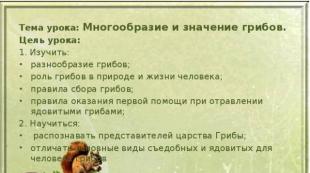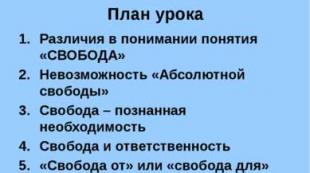Market analysis of household appliances and electronics. Household appliances market: all inclusive! Office equipment and consumables
Almost the entire range of household electrical and radio electronics is currently produced in Russia, however, production mainly consists of assembling products from imported components.
Formally, the main part of refrigerators consumed in Russia, washing machines, televisions, gas and electric stoves, is currently produced by domestic enterprises. However, most factories are owned by foreign companies or carry out contract manufacturing of certain models for them.
Every year, domestic producers go into the shadows more and more, losing their market share to imported brands. In addition, there is no attempt to support domestic production, as is the case with telecommunications equipment manufacturers, where companies can count on tax incentives. The weak interest in the industry from the government is explained by the fact that it is difficult to classify household appliances and electronics as the most high-tech industry, and the number of jobs created by manufacturers in the country is not so large.
If in 2009 the share of domestic production was 4% of the total market household appliances, now the fraction is near zero. Below are the data of the Russian market of household appliances in 2014: Unified interdepartmental information and statistical system [Electronic resource]
- - Computers and computer components, network, multimedia, audiovisual and photo equipment. Import is about 95%, localization of foreign companies with production in Russia is small. The share of national production is near zero.
- - Large household appliances - imports 35-40%, the rest are foreign brands with production in Russia (60-65%). The share of national production is near zero.
- - Television equipment - import 65-70%, localization 30-35%.
- - Small household and kitchen appliances - import 80%, localization 15%, domestic production is about zero.
According to DISCOVERY Research Group, let's consider the size of the household appliances market for the following products:
The volume of the refrigerator market in Russia in 2013-2014 averaged 4.25 million pieces. or $2160.6 mln. in physical terms it was 661.9 thousand units, in value terms - $327.7 million. In the segment of freezers, the average volume for 2 years amounted to 661.9 thousand units. (in physical terms) or $327.7 million (in value terms).
The volume of imports of refrigerators to Russia in 2013 amounted to 1.31 million units. or $432.8 million, and in 2014 1.09 million units. in the amount of $362.6 million. The volume of exports of refrigerators from Russia in 2013 amounted to 367.3 thousand units. or $87 million, but decreased in 2014 -268.8 thousand units. in the amount of $63.6 million.
- - Market size dishwashers in value terms in 2013 amounted to $255.4 million, and in 2014 - $295.43 million. In 2014, the volume of imports amounted to $295.5 million, which is 46% of the total imports - dishwashers from Germany, 21% - from Poland, and 11% are accounted for by Italy and China. The volume of exports of dishwashers from Russia is less than the volume of imports to Russia. According to the Federal Customs Service of the Russian Federation, in 2014, 127 dishwashers were exported from Russia with a total value of $63,507.
- - The volume of the market for steamers in Russia in 2013 amounted to about 1.5 million units. in kind. The volume of imports of steamers to Russia in 2013 amounted to more than 500 thousand units, and according to the results of the first half of 2014 - more than 200 thousand units. According to the results of 2013, the leading positions in the import of steamers to Russia belong to the BRAND trademark.
The imports of steamers to Russia are dominated by Chinese products, which account for about 65% of the volume of imports of this product in value terms. The second place in imports is occupied by products from Thailand, followed by German-made products.
In 2014, about 2.37 million tablets were delivered to Russia. This is 1.4% less than in the same period in 2013. In monetary terms, the market decreased by 33.4% compared to the third quarter of 2013.
At the end of 2014 The first line in the list of leaders in the Russian tablet PC market is occupied by Samsung (16.9%), followed by Lenovo (15.5%), Apple (9.1%), ASUS (9%) and Digma (6.8%) (Figure 2.2).
Figure 2.2 - Leading import manufacturers of tablet PCs in Russia, %, 2014
In 2014, 4.219 million laptops were sold in Russia, which is 32% less than in 2013. The segment of the Russian laptop market decreased by 26.9% compared to 2013, and the deliveries themselves amounted to 4.87 million pieces
At the end of 2014, the weighted average prices for laptops in rubles rose by 13% compared to October, which is even more than the growth of the dollar during this period, and in such a situation it was difficult to achieve truly large sales volumes. There was a "hasty drain into the channel" of all available stocks in warehouses due to the devaluation of the ruble, shipments of laptops already in January 2015 decreased year-on-year by about 60%.
All retail trade enterprises specializing in the sale of household appliances and electronics can be divided into 3 groups: mono-brand retail chains, multi-brand retail chains and private stores. In turn, retail chains and individual trading enterprises are divided into specialized and universal (Figure 2.3).
Figure 2.3 - Classification of trade enterprises in the market of household appliances and electronics
Mono-brand retail chains are retail chains where goods are sold that are produced under only one trade mark or brand. Its owner can be either directly the manufacturer of this product (he is also the owner of the brand), or a company that owns only the rights to sell. A monobrand is usually implemented using various options franchise systems. A mono-brand store is a boutique (or a chain of boutiques) designed according to the style of the brand and reproduced regardless of the country in which the trade is organized.
Multi-brand retail chains are retail chains, the assortment of which is not limited to any one brand, but is represented by several well-known brands. Non-network trading enterprises of household appliances and electronics are all trading enterprises that are not included in the first and second groups.
Get acquainted with large manufacturing enterprises in Russia (Table 2.3).
Table 2.3
The main enterprises-manufacturers of household appliances in Russia, 2015
|
Product groups |
Large manufacturing enterprises |
|
Household refrigerators |
CJSC ZKh Stinol Lipetsk (According to 2009 data, 40% of all refrigerators and freezers produced in Russia); OJSC "Krasnoyarsk plant of refrigerators" Biryusa ", Saratov Electric Unit Production Association, JSC "Moscow plant of domestic refrigerators", OJSC "Orsk Mechanical Plant", PO "Plant named after Sergo" in Zelenodolsk in Tatarstan, JSC "Iceberg" Smolensk plant of refrigerators, Velikoluksky Household Appliances Plant, OJSC "Yuryuzan Mechanical Plant" Chelyabinsk Region, Vestel (Turkey), Aleksandrov, Vladimir Region, BSH Bosch und Siemens Hausgerate GmbH in Strelna, Snaige (Lithuania) Baltic Kaliningrad, "VEKO" (Turkey), Kirzhach, “Helkama Forste Viipuri” (Finland), Vyborg |
|
Washing machines |
Software "Votkinsky Zavod" (Republic of Udmurtia) "Fairy", SE “Plant im. Sverdlov (Nizhny Novgorod region), OKA, Vysokogorsky Mechanical Plant (Nizhny Tagil), "Ural", UE "Omsk Plant of Washing Machines" SE PO "Polyot" (Omsk), "Siberia", CJSC EVGO Group (Khabarovsk Territory), EVGO, Okean Plant LLC, Primorsky Krai, Ussuriysk, DAEWOO and OCEAN PTF Vesta LLP (Kirov), Merloni Elettrodomestici SpA., Candy, Vyatka-Avtomat, LLC "Aviamatika" Moscow, EVRI, "Polar" Moscow, Kaliningrad, Polar; Plant for the production of washing machines, Electrolux (Sweden), St. Petersburg; electrolux, Russian branch of LG Electronics, Ruza, Moscow region. LG; |
|
South Korean company Rolsen (in Fryazino); |
|
|
Washing machine plant Merloni Elettrodomestici SpA., Lipetsk, Indesit, Ariston, "VEKO" (Turkey), Kirzhach, Vestel (Turkey), Alexandrov, Vladimir region, Whirlpool. |
|
|
TVs |
"Radioimport"; Kaliningrad "Sokol" (company "M.Video") LLC "Telebalt" Kaliningrad, Kaliningrad region Samsung, Erisson, Akai Russian branch of Samsung Electronics Vorsino industrial park, Borovsky district, Kaluga region; Russian branch of LG Electronics, Ruza, Moscow region; "VEKO" (Turkey), Kirzhach, Plant of the Turkish company Vestel, on the basis of "Record" Alexandrov, Vladimir region; South Korean company Rolsen (in Fryazino, Kaliningrad); Thomson Multimedia (France) Kaliningrad, Krasnoyarsk, St. Petersburg, Thomson; BMS (previously existed under the name "Baltmikst") two factories in Kaliningrad., assembly of LCD TVs under the brands Philips, Sony and Panasonic; Plant "Arsenal" in Aleksandrov, Syscom; Plant "Kvant" in Zelenograd, owned by AFK "Sistema", Sitronics; Petersburg "Plant named after N. Kozitsky", Rainbow; Plant "Quantum" Veliky Novgorod, Sadko; OJSC Plant "Red Banner", Ryazan, Sapphire; "Polar-TV" Moscow, Kaliningrad, Polar; OJSC Moscow Television Plant "Rubin". The OJSC includes an enterprise for the production of TV sets in Voronezh "Videofon"; GUPP "Radiozavod" Penza, Volna; Korean company LG, Zelenogorsk electrochemical plant (Krasnoyarsk-45), Building "Electrosignal" Voronezh, VELS; V-Laser Company, Ussuriysk, Primorsky Territory, Coral, Ocean; State Unitary Enterprise Far Eastern Radioelectronic Plant "Avest", Komsomolsk-on-Amur, Khabarovsk Territory LG, Avest; Company "EVGO" Khabarovsk, Evgo. |
In the first quarter of 2015, the Russian home appliances and electronics market showed a 14.5% decrease in turnover compared to the same period last year, after a surge in sales at the end of 2014.
Dynamics of the volume of the market of electrical household appliances and electronics in Russia:
Audio and video equipment: declining sales of basic goods
The first quarter of 2015 was marked by a decline in demand for consumer electronics compared to the same period in 2014. Sales of TV sets and navigators for cars have especially strongly decreased to 50%. However, consumers continue to show interest in UHD technology and, in March 2015, the share of UHD in TV turnover exceeded 9% of all sales. Digital signal receivers and soundbars without a drive are the only segments in the market for which the money turnover in rubles increased in the first quarter of 2015.
Large home appliances: tougher competition
Demand for large household appliances at the beginning of 2015 is characterized by instability. After a boom in sales and a 70% increase in demand at the end of 2014, demand is now down. Turnover in January was lower than last year by only 7%, and in March - by more than 40%. Nevertheless, with the strengthening of the ruble in recent weeks, there has been a slight decrease in retail prices, which, if this process continues, may have a positive effect on demand.
Small Appliances: Demand for Beauty and Health Products Remains
According to the results of the first quarter of 2015, the market of small household appliances showed a decrease in turnover by 11.8% and a decrease in demand by -27% in pieces. This discrepancy is observed due to a significant increase in prices by more than 20%. The most stable demand is for health and beauty products and coffee machines - the turnover is almost at the level of the 1st quarter of 2014 (20%). Despite the overall decline in sales in the small home appliances market, the Internet is still showing positive growth rates, which is very supportive of the MBT sector as a whole.
Information technology: fall and degradation
After the changes in the ruble exchange rate at the end of 2014 almost doubled the prices of the Russian IT market, two main trends remained on it: a decrease in demand and a transition from middle-class models to entry-level models in the main product groups. The ruble volume of sales of the IT market decreased by only 20% in the first quarter, but in physical terms, computers were sold 40% less, as well as monitors. In the first quarter of 2015, about 1 million desktop and laptop PCs were delivered to Russia. This is 43.6% less than in the first quarter of 2014. Companies - leaders in the PC market in the first quarter: Lenovo - 22.2%, Hewlett-Packard - 16.8%, Acer - 10.5%, ASUS - 8.7%, DNS - 6.3% (Fig. 2.4).

Figure 2.4 - Leading import manufacturers of desktop and laptop PCs in Russia, %, 2015
Telecommunications: new reality, new prices
In the first quarter of 2015, the telecommunications equipment market experienced a noticeable drop in demand (almost -15%), which is much less than in other sectors, but remained the only one that showed an increase in turnover (+3.7%) due to a price increase of almost for all models. The facts speak for themselves - buyers still pay more for the same models, not to mention new ones.
After the change in the exchange rate of the ruble at the end of 2014 increased the price of electrical appliances from 15% to 40% depending on the sector. All buyers who did not have time or could not make a purchase in December last year are now looking for necessary equipment, not only focusing on the characteristics, but also on the price level. There is no shortage of goods in retail, which buyers feared. The decrease in demand is more dependent on family budget, which has not become more GfK - a source about consumer markets and the consumer [Electronic resource].
In Russia, the number of household appliances stores, hypermarkets and electronics supermarkets is growing every year. With the advent of specialized hypermarkets in the cities, many small household appliance stores were forced to cease their existence. With the advent of federal-level companies to the market, big changes began for regional networks, competition in the industry has significantly increased.
The change takes place not only at the level of the store format, the buyer himself, his needs and requirements are also changing. According to marketing research, for Russians, the first place is still the cost of household appliances. Today, consumers are not ready to overpay for goods, and hypermarket chains, as a rule, offer their customers reasonable prices, holiday discounts and other discount programs.
The study analyzed 10 federal and 35 regional networks operating in 100 cities of the Russian Federation. The total selling space of household appliances and electronics stores located in the cities under study is divided among the five main market players. The leader is the M. Video network, which occupies 24%. A little less - Eldorado, which accounts for 21% of the area. In third place is Technosila (11%), followed by Media Markt (7%) and Expert (6%). Thus, the share of the five largest retailers in total accounts for 69% of retail space occupied by household appliances and electronics stores. Other market players, including local networks, occupy 31%.
A variety of household appliances presented in our country is able to satisfy the tastes of even the most demanding consumer. The geography of the supplied products is very diverse, and the number of famous brands is just as large.
An analysis of the development of the Russian household appliances market made it possible to identify a number of trends in its development:
- – dependence on import supplies;
- – an increase in the number of Western enterprises operating in Russia;
- – slowdown in sales growth in the home appliances and electronics market;
- – reduction in sales of phones and smartphones to 38-39 million units (which is lower than the same indicator in 2014 by 20-25%);
- transition from price competition to non-price competition.
To further change the situation, major players have developed and are implementing anti-crisis measures:
- - optimization of the assortment, increase in the assortment of the share of the mid-price segment, etc.;
- - there is an increase in sales of household appliances through Internet - trade;
- – further promotion of large retail chains of household appliances to regional markets;
- – further growth of basic and additional services;
- – growth in sales of household appliances through mobile applications;
- – further development of multi-channel sales;
- – there is stagnation in the segment of cell phones and smartphones.
Forecast for the development of the Russian household appliances market for 2015:
- – the economic downturn and the decrease in consumer activity will affect the dynamics of the development of the home appliances market, a decrease in the growth rate of sales in the whole market of home appliances in Russia is predicted;
- – further decline in profit growth rates trading companies in this market;
- – decrease in sales in the cell phone segment by 17-18% compared to 2014;
- – reduction in sales of phones and smartphones to 38-39 million units (which is lower than the same indicator in 2014 by 20-25%);
- - switching consumer preferences to cheaper models in all categories of household appliances;
- – further strengthening of competition in all segments of the household appliances market;
Send your good work in the knowledge base is simple. Use the form below
Students, graduate students, young scientists who use the knowledge base in their studies and work will be very grateful to you.
Similar Documents
Consideration theoretical foundations advertising campaign design. Analysis of the activities of OOO "Vash Dom". The study of advertising competitors in the market of household appliances and electronics in Naberezhnye Chelny. Features of the project of the advertising campaign of LLC "Vash Dom".
term paper, added 02/03/2015
Ways to obtain marketing information. Market analysis of household appliances in the city of Zhovti Vody. The attitude of buyers to purchase. Experimental study of the demand for household appliances in the store "Komfi", "Holiday", "Jubilee", the results of the survey.
test, added 10/16/2013
Classification of types of competitive behavior of enterprises. Main types, methods and strategies of competition. Market research retail household appliances and electronics in Karpinsk on the example of the companies of competitors "Line Toka" and "Northern Wind".
term paper, added 04/18/2015
Analysis of the household appliances market in St. Petersburg. Analysis of competitors and consumers. Development of the main sections of the business plan. Designing the organizational structure of the store. Marketing plan. Production plan. Implementation plan.
thesis, added 02/23/2005
Characteristics of an enterprise selling electronics, household appliances in Russian Federation. Evaluation of the end consumer market of the product, distribution channels and competitiveness of the company. Organization of marketing at the enterprise and analysis of its communication policy.
term paper, added 11/22/2015
Consumers as an object of marketing behavior. Factors affecting the consumer. Modeling consumer behavior. Analysis of the process of choosing and buying household appliances and electronics in families. Stimulation of consumer activity.
term paper, added 11/22/2013
Methods for assessing competitiveness. The current state of the market of small household appliances and the forecast of its development. Calculation of the competitiveness of domestic household appliances of the company by the differential method. Competitiveness index calculation.
term paper, added 09/28/2002
The essence of the marketing activities of a trading enterprise. Sales promotion activities. a brief description of Russian market of household appliances and electronics. Sales channels and organization of goods distribution. Improvement of commercial activity.
thesis, added 02/21/2016
Specialists of the Russian retail network "M.Video" have prepared an analytical review of the Russian market of household appliances and electronics based on the results of 2015. According to the results of the study, sales in the sector fell by 19.6% and amounted to 1.1 trillion rubles.
Sales at M.Video also showed a negative trend, falling by 5.5% to RUB 191.9 billion. The company notes that in 2015 the share of M.Video in the Russian market of electronics and household appliances increased by 2.4% and reached 16.1%.
Cash payments are gradually losing popularity, giving way to more modern ways. In 2015, the share of buyers choosing non-cash payment increased from 35% to 39%. M.Video analysts attribute this to the active penetration of plastic cards into the regions.
According to the report, last year the most popular were large household appliances, audio and video equipment, computers, mobile devices, as well as small household appliances. At the same time, smartphones entered the Top 5 product categories for the first time. The average check in retail chain stores was 6,760 rubles, and the average purchase on credit was 29,000 rubles.

The share of online sales in M.Video's turnover increased from 9% in 2014 to 11% in 2015. The company's customers increasingly prefer self-pickup to courier delivery, the share of which has grown from 66% to 69%. The average check for pickup from the store was 11,013 rubles, and for home delivery - 21,345 rubles.
 Mobile sales are also growing: in 2015, 38% of purchases in the retailer's online store were made from mobile devices (growth by 2014 was 40%). Of these, 27% are from smartphones, and 11% from tablets.
Mobile sales are also growing: in 2015, 38% of purchases in the retailer's online store were made from mobile devices (growth by 2014 was 40%). Of these, 27% are from smartphones, and 11% from tablets.
Internet traffic in the regions was distributed as follows: the most active are online users from Moscow and the Moscow Region (31%), from St. Petersburg and the Leningrad Region (7%), and also from the Krasnodar Territory (5%).

The volume of the market of "smart" phones increased by 9% in monetary terms and amounted to 267 billion rubles, but sales in units decreased by 5% to 26.2 million devices. The dynamics of growth in sales of smartphones in M.Video in money terms amounted to 51%, and in quantitative terms - 7.5%. Analysts emphasize that the devaluation of the ruble had a significant impact on the average cost of a smartphone: the figure increased by 14% and reached 10,190 rubles.

The position of mobile devices on Android has been strengthened due to a wide range of B-brand smartphones in the middle and low price segment.
According to the report for the first quarter of 2016, Android devices still account for the largest market share (87%). iOS remains in second place (10%), and Windows is in third (2%). In monetary terms, Android fell by 3%, iOS grew by 27%, and the share of Windows decreased by 3%.

The headphone market increased by 18% to RUB 9.9 billion. The share of M.Video in the segment is estimated at 13.5%, while sales of headphones and headsets in the stores of the network grew by 40% in monetary terms. Most often purchased products in price category up to 1,000 rubles, and the Top 3 manufacturers in terms of money included Sony (21.3%), Sennheiser (13.1%) and Philips (12.9%).
 In parallel with the dynamic development of the smartphone market, the segment of smart devices that are easily synchronized with mobile devices is actively developing. In this group of products, the most popular are smart bracelets and fitness trackers. In 2015, sales of such devices grew by 43% in monetary terms and by 51% in unit terms, to RUB 300 million. and 62,000 pieces, respectively. Jawbone remains the market leader, accounting for up to 70% of sales.
In parallel with the dynamic development of the smartphone market, the segment of smart devices that are easily synchronized with mobile devices is actively developing. In this group of products, the most popular are smart bracelets and fitness trackers. In 2015, sales of such devices grew by 43% in monetary terms and by 51% in unit terms, to RUB 300 million. and 62,000 pieces, respectively. Jawbone remains the market leader, accounting for up to 70% of sales.

The notebook market continues to show negative dynamics. Compared to 2014, sales decreased from 105.3 billion to 81 billion (by 23%). In quantitative terms, the indicators fell from 4.9 million units. up to 2.9 mln. (by 60%).
Share of online sales in the notebook market grew: from 20% in 2014 up to 24% in 2015. However, the volume of online sales decreased by 8% and reached 19.5 billion. Most often, buyers purchase devices under the brand Lenovo (29.3%), Asus (22.9%) and Acer (16.5%).

Tablets are becoming less and less popular among Russians. Sales in the segment fell by 31% to 54.3 billion rubles, and in units decreased by 30% to 6.6 million devices. Despite the general decline in the tablet market, unit sales in M.Video grew by almost 17% year-on-year, and the company's share reached 13.5%. Tablets with a diagonal of 7” were in the highest demand on the market, and Samsung with a market share of 20.3%, Apple – 19.8% and Lenovo – 14.9% were in the top three.
Tablet PC sales fell 33% in 2015, according to a study by the company. Last year, 6.2 million tablets were sold on the Russian market, while in 2014 - 9.3 million devices.

The home console market fell 40% in unit terms and 18% in monetary terms. In 2015, the market volume was estimated at 8.6 billion rubles. and in 435,000 pieces. The average market price of the console increased from 15,800 to 21,000 rubles, and the PlayStation 4 became the clear leader in sales.
 Over the past year, sales of gaming accessories have grown. In particular, online sales of gaming mice increased by 50% in monetary terms, gaming keyboards - by 92%, gaming headphones - by 82%. The share of online in total category sales was 18%, 23% and 21%, respectively.
Over the past year, sales of gaming accessories have grown. In particular, online sales of gaming mice increased by 50% in monetary terms, gaming keyboards - by 92%, gaming headphones - by 82%. The share of online in total category sales was 18%, 23% and 21%, respectively.

In 2015, the photographic equipment market showed a significant decline in both monetary and quantitative terms. The volume of the segment in money amounted to 18 billion rubles (a decrease of 39.4%), and in units - 1.3 million devices (a decrease of 52.7%). In the DSLR and Compact Cameras categories, Nikon leads with 48% and 37% respectively, while in the System Cameras category Sony leads with 59%.
 Despite the decline in the market for photographic equipment in 2015, the category of action cameras showed significant growth. The market volume increased by 68% and amounted to 1.5 billion rubles. The number of cameras sold increased by 59% to 116 million. M.Video expects continued growth in sales of action cameras, which will be associated with the release of new devices by already known and new market players.
Despite the decline in the market for photographic equipment in 2015, the category of action cameras showed significant growth. The market volume increased by 68% and amounted to 1.5 billion rubles. The number of cameras sold increased by 59% to 116 million. M.Video expects continued growth in sales of action cameras, which will be associated with the release of new devices by already known and new market players.

Over the past few years, DVRs have grown from a small segment into a sought-after category. Even with a decline in traffic in 2015, the technology remains promising due to its impartiality in identifying the perpetrators of road incidents. In 2015, the category of combidevices was actively developed - a radar detector and a video recorder in one device.

In 2015, the demand for TV sets in Russia fell by 47%, to RUB 130.5 billion, while turnover decreased by 33%, to 5.3 million units. The share of Ultra HD TV in the market was 15.2%: sales of such TVs grew by almost 50% in unit terms and by 37% in monetary terms, while the average price fell by 8%. The proportion of TV sets with curved (Curved) screen increased by 2 times (up to 6.2%).

According to the report, in 2015 the positive dynamics in the "Audio systems" category was demonstrated by portable devices - All-In-One and Network Media System (network audio solutions, or multi-room). Sony and LG remain the leading players in the home audio market, with combined market share close to 70%.
 In the market of large household appliances, there was approximately the same drop in sales separately standing stoves and built-in ovens in unit terms, but due to a stronger increase in the average price of built-in ovens the fall for them in monetary terms was almost 10% less than for the slabs. Top 3 manufacturers by turnover included Bosch, Siemens (14%), Gorenje (13%) and Hansa (12%).
In the market of large household appliances, there was approximately the same drop in sales separately standing stoves and built-in ovens in unit terms, but due to a stronger increase in the average price of built-in ovens the fall for them in monetary terms was almost 10% less than for the slabs. Top 3 manufacturers by turnover included Bosch, Siemens (14%), Gorenje (13%) and Hansa (12%).

In 2015, the market for small household appliances decreased by 13% in monetary terms. The fall in demand has affected the kitchen appliances, and the most resilient to market changes was the technology for making coffee.
Sales of automatic coffee machines remained at the level of 2014, while buyers prefer to invest in more advanced solutions, despite the increase in the average price: more than half of the market (55%) is accounted for by automatic coffee machines and coffee makers, 20% by capsule and 14% by carob . Top brands include Delonghi, Saeco and Bosch.

Other small household appliances:


Experts note the development of the Russian drone market. The main growth drivers are inexpensive amateur models. In 2015, the average price of a drone was 17,000 rubles, a quadcopter - 5,500 rubles, and a radio-controlled toy - 3,500 rubles. In addition, M.Video predicts continued growth in sales in the category of professional drones in 2016.

Every year, the consumer makes more and more demands not only on product quality, but also on the place of purchase. First of all, we are talking about suppliers of consumer goods. For example, household appliances and electronics. The main trend in the development of this market today is the enlargement of existing participants. Simply put, small networks merge into large ones or close, unable to withstand fierce competition. Over the past 5-6 years, such takeovers have become the norm. Of course, the market dictates its own conditions, and the consumer, in turn, sets the conditions for it.
Change of strategy
Experts note: the consolidation of players in the consumer electronics market, the increase in the format of stores is a requirement of the time. Why is this happening? The thing is that the buyer wants to not only buy what he needs, quickly and without special costs time and effort. He strives to buy everything in one big store. That is why lately so many hypermarkets are being built. Owners of chains of household appliances quickly orientated themselves in the changing market. Not only in Moscow and St. Petersburg, but also in other major cities countries began to open large centers with an assortment for every budget: from calculators and cell phones to expensive built-in equipment. Moreover, the client requires maximum convenience: good relationship from sellers, lack of queues, minimum prices and a wide range of products. As well as the availability of additional services: convenient parking, snack bars, entertainment for yourself and children.
Situation in the industry
Today, the market for household electrical appliances, which was clearly structured until recently, is undergoing major changes. According to analysts, there are about 10 thousand companies (manufacturers and sellers) in the industry, but 70% of sales are accounted for by a dozen large retailers and about 20 manufacturers. And the consolidation of existing participants continues. It happens in different ways. The simplest is the extensive way (increasing the number of stores for each of the market participants). This path is the most obvious, but also the most expensive, since it is quite expensive to build or buy a store. In addition, in the case of construction, a certain time is required, and it is extremely important to be the first in a particular region. Nevertheless, the largest players in today's market are developing along this path. One of them "M Video". The company is on a different path. "Expert". It uses a franchising system, that is, it combines existing stores under a common brand name, which determines the image, strategy and tactics of store development. "El Dorado" and "Technosila" combine both development paths - they open both their own stores and franchising.
Each participant in this market develops according to its own scenario, however, in recent years, Western networks have begun to seriously influence the competition. A vivid example Media Markt. The company came to Russia just a few years ago. However, its activity, coupled with the rapid conquest of the domestic audience, has already forced large Russian networks to pay close attention to the regions. And this is another trend in the field of sales of household appliances. The capital market is oversaturated with both federal and local chains. In this connection, experts say, consumer demand has sharply decreased. Everything is trite - people have already bought all the necessary equipment. It is of high quality and does not require frequent replacement. A new period is coming: either to offer something completely new, or to expand the regional representation. Most choose the second option.
In regional centers, federal networks are being enlarged by absorbing local electronics sellers. Small shops are closed or reformatted. New points of sale are opening with a sales area of 1000 sq. m.
Care in the regions
One of the striking examples of recent years, clearly showing the expansion of federal networks at the expense of the regions, was the merger of the Ural company "Rembyttechnika" with one of the leaders in the field of sales of household appliances, the Expert company.
What is significant about this deal? Firstly, as mentioned above, this indicates a clear trend: the leading players in the electronics market, under the influence of various factors, are transferring highly competitive struggle with each other to the regions. Secondly, the result of this confrontation is their consolidation through the absorption of local networks. And finally, thirdly, everyone wins here: the federal eliminates a competitor and strengthens, the owner of the regional network sells his business profitably, and the buyer ultimately gets the opportunity to even more favorable conditions buy quality equipment.
True, there are relative disadvantages of such a transaction. Now the company has a double name "Expert-Rembyttechnika" and has been in a state of rebranding for several years. The matter is that the Ural client is very accustomed to the local company and trusts it. In this connection, the abandonment of the former name would greatly limit the ability of the feds to quickly attract an audience. Therefore, the transition is carried out gradually: the service centers remained under the Rembyttekhnika brand, and the stores are called Expert.
Merger of market leaders
And here new example and a new trend: the leading chains of the Russian household appliances market may soon unite. The relevant documents on the merger of M.Video and Eldorado have already been submitted to the FAS. True, here one company buys another, but this does not change the essence of the matter - there is a movement towards monopolization of the sphere.
Now M.Video, represented by its main shareholder in Cyprus, is acting as a buyer Svece Ltd owned by Alexander and Mikhail Tynkovan. But literally in 2011 the situation was just the opposite. Then Eldorado, co-owned by PPF Group Peter Kellner, tried to negotiate with the owners of M.Video about the purchase. And this once again speaks of the rapid development of the consumer electronics market, where yesterday's sellers are becoming buyers of a business with a working capital of hundreds of billions of rubles.
According to experts, the execution of the transaction can be very delayed. It may take from one year to three years. And if this happens, then M.Video will take about 40% of the entire market with more than 500 stores. Although the FAS, of course, will not allow this. Under the current legislation, the dominance threshold cannot exceed 35%. Experts believe that the new leader will have to reduce business volumes. But against the background of the elimination of a direct competitor, this will not become critical.
prospects
Home appliances and electronics business owners are now interested in two main questions: what are the prospects for large players and is there a chance for small chains to survive? Again, the market prompts the answers. Western "colleagues" set new standards for domestic leaders. Russian networks began to feel increased competition from chain hypermarkets. The latter work according to the principle all inclusive
, providing, as previously mentioned, a full range of products, conditions and services. For example, in America, specialized stores for the sale of household appliances began to close, which could not withstand the pressure from the hypers. In Europe, however, this trend is still not clearly visible. It is possible that in Russia, as always, they will choose their own path. Moreover, the format of a specialized home appliances store is still in demand.
Meanwhile, regional chains do not plan to give up either. They are ready to defend their market positions in the field and, moreover, have plans to expand the business. Regional companies have a number of advantages over federal ones. One of the main disadvantages big business- loss of network flexibility and responsiveness to customer requirements. This is where the regionals will play.
The main factors behind the growth in the turnover of the household appliances market in Russia in recent years have been the rapid growth in the welfare of the population and favorable
macroeconomic situation. According to the DISCOVERY Research Group, in 2008 the domestic appliance market in Russia amounted to $10.8 billion.
However, the global financial crisis, the acceleration of inflation in the consumer market and the slowdown in the growth of money incomes of the population led to a decrease in the turnover of the household appliances market already in the second half of 2008. As a result, in 2009 the market fell by 25% to $8.1 billion. Currently, the market has begun to recover, but according to GfK research in Russia, this year it is unlikely to show rapid growth: in 2010, about 5% is expected. growth of this market (according to http://marketing.rbc.ru/news_research/22/03/2010/562949977996081.shtml and http://planovik.ru/research/2010/03/22/3672.html)).
The household appliances market accounts for about 60% of the total household appliances and electronics market. Nevertheless, the Russian household appliances market continues to be considered the most promising and fastest growing in Europe.
Despite the fact that retailers are making every effort to reduce costs and optimize costs, prices for household appliances are rising and there is a slight decrease in consumer activity. Experts believe that if the ruble falls further against the world's leading currencies, this may lead to an increase in prices for household appliances. At the same time, buyers still limit themselves to the most necessary and inexpensive purchases, carefully choose and continue to postpone large purchases in anticipation of sales and better loans (based on http://marketing.rbc.ru/news_research/22/03/2010/ 562949977996081.shtml and http://www.e-o.ru/publisher/45817.htm).
In value terms, in the structure of the Russian market of household appliances and electronics, the largest share belongs to the segment of audio-video equipment (38.1%), the share of large household appliances is slightly less - 36.4%. The shares of small household appliances and photographic equipment are 17.4% and 8.1%, respectively (Figure 1).
Picture 1.
Structure of the Russian market of household appliances and electronics*
Main conclusions:
The home appliance market has grown steadily over the past few years. However, the global financial crisis, the acceleration of inflation in the consumer market and the slowdown in the growth of money incomes of the population led to a decrease in the turnover of the household appliances and electronics market.
Consumer demand is characterized by the most necessary and inexpensive purchases, careful selection and postponing large purchases in anticipation of sales and better loans.
In the structure of the Russian market of household appliances and electronics, about a third belongs to the segment of audio-video equipment, almost the same share of large household appliances. The share of small household appliances and photographic equipment in the overall structure is much smaller. The biggest decline in sales was observed in the 2nd quarter of 2009. In 2010, a stable trend is observed: pre-New Year sales of home appliances are traditionally high, and the February-March holidays made it possible not to slow down the pace of sales. Retail players in the home appliance market were also hit hard. Almost everyone has foreign debts. The main anti-crisis measures were assortment optimization, emphasis on the mid-price segment, the release of new products, promotions to attract and retain customers.
According to experts' forecasts, the household appliances market will be able to reach pre-crisis volumes only by 2012.









